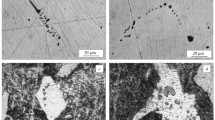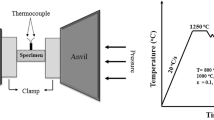Conclusions
-
1.
An increase of the cooling rate of high-speed steel at the primary crystallization temperature is accompanied by refining of grains and carbides.
-
2.
At the maximum cooling rate, achieved by atomization of the liquid steel, part of the carbon and alloying elements is not transferred to the eutectic, which leads during subsequent sintering to precipitation of the finest carbides from the solid solution.
-
3.
Sintered high-speed steel has higher strength and toughness and the same secondary hardness and heat resistance as the standard steel.
Similar content being viewed by others
Literature cited
A. K. Petrov et al., "Study of atomized powders of high-speed steels and sintered products," Poroshk. Metall., No. 3, 9 (1971).
Yu. A. Geller et al., "Structure and properties of high-speed steels produced by sintering of atomized powders," in: Progressive Designs and Methods of Treatment in the Tool Industry [in Russian], Perm (1975), p. 41.
Additional information
Deceased.
Moscow Machine-Tool Institute. Translated from Metallovedenie i Termicheskaya Obrabotka Metallov, No. 6, pp. 44–46, June, 1979.
Rights and permissions
About this article
Cite this article
Geller, Y.A., Kremnev, L.S. & Salmanov, N.S. Structure and properties of high-speed steels in relation to the cooling rate in the temperature range of primary crystallization. Met Sci Heat Treat 21, 464–467 (1979). https://doi.org/10.1007/BF00780485
Issue Date:
DOI: https://doi.org/10.1007/BF00780485




